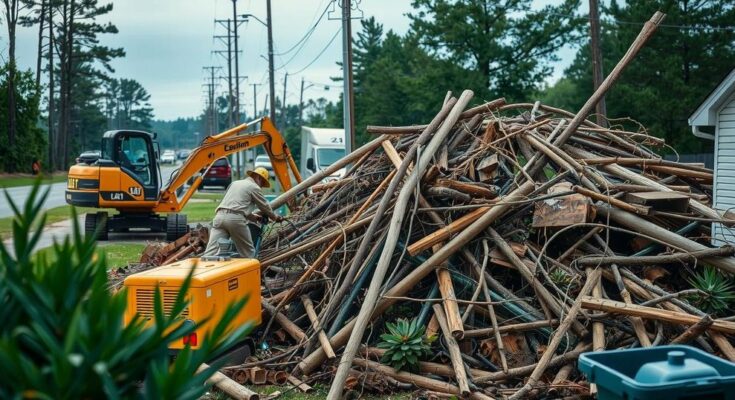The Virginia Department of Transportation estimates three to six months for debris cleanup following Hurricane Helene, which caused over $4 billion in damages. The storm impacted areas of Southwest Virginia, leading to significant collaboration between state and federal agencies for recovery efforts. VDOT plans to secure full federal reimbursement for cleanup costs, while ongoing efforts will focus on both terrestrial and aquatic debris removal.
The Virginia Department of Transportation (VDOT) has assessed that the debris cleanup following Hurricane Helene will require an estimated three to six months. The storm, which resulted in over $4 billion in damages and claimed the lives of three individuals, wreaked considerable havoc in the Appalachian region of Southwest Virginia. The initial presentation regarding the debris removal timeline is to be discussed at the upcoming Virginia Commonwealth Transportation Board meeting.
According to Jessica Cowardin, a spokesperson for VDOT, this process involves a careful, route-by-route examination to remove debris, secure unsafe leaning trees, and clear displaced soil and rock. Hurricane Helene made landfall in Florida on September 26, 2023, before impacting Southwest Virginia the next day, causing significant flooding and power outages across the area. In response, Governor Glenn Youngkin communicated an overall damage estimate of $4.4 billion to federal authorities.
To facilitate recovery efforts, the state has established a collaboration with federal and local partners to ensure Virginia can secure essential federal resources for disaster relief. VDOT plans to obtain full federal reimbursement for its cleanup activities over a span of three years, which will cover costs through programs offered by the Federal Emergency Management Agency and the Federal Highway Administration. Preliminary funding distributions have already commenced to assist individuals affected by the storm.
The aftermath of Hurricane Helene has left approximately 511,000 cubic yards of debris, with VDOT having effectively removed 110,000 cubic yards, complemented by contractor efforts resulting in an additional 6,000 cubic yards removed. Cowardin noted that this cleanup strategy was informed by historical data related to prior storm recovery efforts.
Furthermore, a Debris Task Force has been assembled, consisting of various federal and state agencies, including FEMA and the U.S. Army Corps of Engineers. The cleanup will also address approximately 135 acres of debris within Claytor Lake, employing specialized equipment such as survey vessels and cranes. Recently, FEMA also announced a multi-million dollar commitment for debris removal from both Claytor Lake and the South Holston Lake area over a four-month period, as removing debris from waterways presents unique challenges, according to Col. Sonny Avichal, commander of the USACE Norfolk District.
In conjunction with the debris cleanup, VDOT is set to outline a timetable of about 12 months for the reconstruction of damaged roads and infrastructures. Initially, there were 414 damaged roadways and 99 affected structures, but there are currently only seven roadways and four structures still awaiting repairs. Specific impacted routes include Routes 58 and 1212 in Damascus, along with the Route 725 bridge in Taylor’s Valley.
Hurricane Helene significantly impacted the southwestern region of Virginia upon making landfall in late September 2023. The storm not only led to tragic loss of life but also resulted in extensive destruction to property and infrastructure, with damages totaling billions of dollars. The Virginia Department of Transportation’s debris cleanup strategy involves collaboration with various governmental agencies and utilizes historical data to develop realistic cleanup timelines. Efforts are also underway to secure federal financial assistance to facilitate recovery and restoration in affected areas. The complexity of debris removal is amplified by the need to address both terrestrial and aquatic debris.
In conclusion, the debris cleanup following Hurricane Helene is expected to be a lengthy and complex process, projected to take three to six months. With significant coordination among various governmental agencies, efforts are focused not only on collecting debris but also on ensuring the safety and rehabilitation of the affected regions. The financial implications of the storm have prompted state leaders to seek federal assistance to expedite recovery and provide necessary support to those impacted.
Original Source: virginiamercury.com




